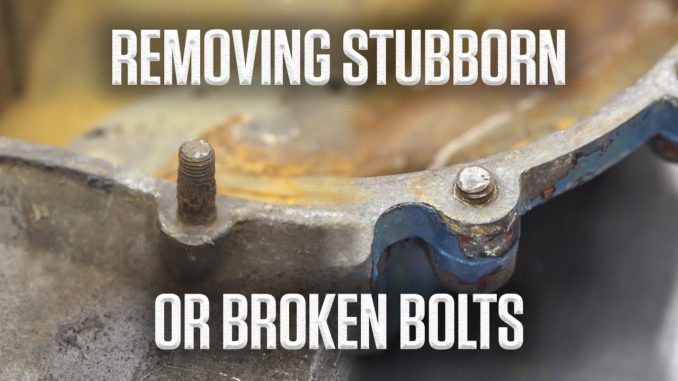In the case of a broken exhaust manifold bolt, welding is not the only option, but some technicians rely on this single approach. We all know that one approach does not fit all applications so the application is the driver for this repair. Completing the repair in minutes or hours depends on which process you use to determine the application.
A MiG welder is the preferred tool for this job, but a stick welder, depending on where the break occurred (depending on the application: above, below, or flush with the cylinder), may also do the trick. To start, select a nut or flat washer with an inner diameter roughly the size of the stuck threaded bolt. Place the flat washer and/or nut on the bolt and weld the inside of the nut to the broken top of the bolt. Then use a wrench to remove the nut and bolt together.
Some technicians avoid the washer/nut combination altogether and simply “build” the weld creating a custom-fitted bolt that once above the surface of the head can be removed later. The welding process can be lengthy. The remnant needs to be cleaned in order for the weld to adhere, the temperature needs to be right in order to avoid burning the head, and the steel you are welding to needs to be understood.
For example, titanium alloy bolts found in most turbocharged engines take a great deal more heat to fuse to and much greater caution. Plus, getting a welding head into limited access, low-vision areas presents another set of challenges. Lastly, welding is not 100 percent effective in every situation. Just like other repairs, not any single solution works universally across all situations.
Drilling out a broken stud or bolt can be an intimidating task for some technicians, especially if the bolt is of a smaller diameter, such as the case of an exhaust manifold bolt (8mm), and a cold reminder there is only a few thousands of an inch of cast aluminum web separating the water jacket from the manifold bolt. The traditional method includes taking a punch and creating a divot (or center point) on the broken bolt surface, drilling a pilot hole freehand, hammering in an easy out extractor, then attempting to back the bolt out. Even the greenest technician can manage this task, however, it can come with a series of things that can go wrong or create a bigger mess than when you started.
The traditional method includes taking a punch and creating a divot (or center point) on the broken bolt surface, drilling a pilot hole freehand, hammering in an easy out extractor, then attempting to back the bolt out. Even the greenest technician can manage this task, however, it can come with a series of things that can go wrong or create a bigger mess than when you started.
The most common issue comes from using cheap materials and off the shelf drill bits which can lead to off-center drilling. Walking drill bits and extractors can break and lengthen the repair cycle and rob your productivity and profitability. Lastly, drilling free hand and off-center introduces a torque moment at the center of the bolt which increases the energy required to remove the broken remnant, often exceeding torque specs of the extractor.
Understand the application. Use the right tool for the right application, one size does not fit all. ProMAXX believes these two approaches (drilling and welding) can be used together and depending on the application, exceed expectations. For broken bolts above the head, weld. For broken bolts flush or below the head, drill.
Use the right tool for the right application, one size does not fit all. ProMAXX believes these two approaches (drilling and welding) can be used together and depending on the application, exceed expectations. For broken bolts above the head, weld. For broken bolts flush or below the head, drill.
In terms of a specialty tool, it is recommend with drilling to try the ProCutter - Deburring Tool
When manifold bolts are heated to high temperatures when exposed to water from the road or condensation, they can break under the slightest bit of tension. When these bolts break, it’s because they are actually stretched, thus elongating the threads. This environment often leads to a partial thread being left behind locking the stud into the softer aluminum of the head.
You’ve got to go in and clean the debris, corrosion, and partial thread that is left behind, and this is where and why welding will fail. By using the ProCutter, with its unique design that consists of a four-blade cutting edge screwed onto an arbor that attaches to a 1/4” drill, you can knock the burr of the broken remnant in just five seconds making it ready for extraction.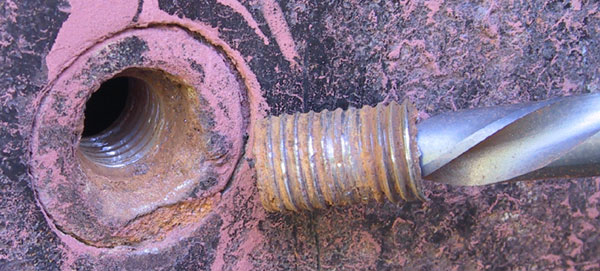
 Then, turn the splined straight extractor clockwise first to unlock the stud, then counter-clockwise to remove it.
Then, turn the splined straight extractor clockwise first to unlock the stud, then counter-clockwise to remove it.Information provided by ProMAXX
11/19/2022 Machining Rebuilding Repair, Repair Tips Comments Off on Broken Bolt – Stud Removing – Can Be A Frustrating Time Waster
Broken Bolt - Stud Removing - Can Be A Frustrating Time WasterBroken bolt and stud removing, can often be a frustrating time waster, with no quick fix available.So, it never fails! Just when you think you have got the whole job taken apart and everything is under control. You either twist off a nut, break or round off a screw, or strip out the threads entirely.
More often than not, removing the broken piece and/or repairing the broken threads. Can take longer than, all the whole job itself.
Can take longer than, all the whole job itself.
There are however, a few tips, tricks and tools, that might make the job easier. So, the job can’t proceed, until the fastener is removed. And, of course, you didn’t allow for all that extra time, did you? What to do now? What alternatives are there to get the bolt out? Probably the best piece of advice is, not to panic.
There are, in fact, many different ways to get broken bolts and screws out. Which method you use, will depend upon the circumstances and also your available tools.At a minimum, I recommend every hobbyist own:
On top of this, they should also know about the different parts of a drill. And, how to a drill correctly.
Broken Or Rusted StudBroken Or Rusted StudSo, if there is a stub sticking out, an effort must be made to grab it, with Vise-Grip locking pliers.
If it can’t be gripped, try to carefully turn it out of the hole, with a hammer and chisel. A bolt remnant, that has broken off flush or below the surface of the workpiece. Will usually be loose in the threads. In such a case, it often works to carefully use a punch or chisel. And, drive on the outer perimeter of the bolt, to turn it counterclockwise.
Weld On Washer Or NutWeld On Washer Or NutIf the above efforts fail, then you will need to:
One often overlooked method of removing broken screws and bolts. And, perhaps the best first choice, is the left hand twist drill bit. These are the same as regular high speed drill bits. However, the cutting action is in a counterclockwise direction. As a result, it might just unscrew.
However, the cutting action is in a counterclockwise direction. As a result, it might just unscrew.
So, you will likely have to, drill a pilot hole at this point. Consequently, if you use a left hand drill bit, in many cases the drilling process, results in removal. Because, you are turning and biting into the stuck fastener in the same direction as removal. For this reason, you should be looking at, some of the better quality drill bits.
The Use Of HeatOften a last resort, the application of heat to a stubborn, immovable fastener, can be the catalyst for success. So, why apply heat? Because, it excites the molecules in the metals, causing expansion. This expansion can take place, at different temperatures and rates for different metals.
One of the most common examples is, the heating of cast iron manifolds to remove stubborn steel studs.
Being dissimilar in structure, the cast iron heats and expands at a rate, greater than the steel fastener. As a result, allowing a space to form, between the two and facilitates easier removal. The added use of penetrating fluids, that can withstand high temperatures, enhance the chances for success.
As a result, allowing a space to form, between the two and facilitates easier removal. The added use of penetrating fluids, that can withstand high temperatures, enhance the chances for success.
If all these methods fail to remove the broken bolt. Then, the only choice is to drill it out completely. The one downside is, this means drilling away the mating threads. In this case, you will have to tap new larger threads into the hole and find a larger bolt.
Now you can save time with Broken bolt and stud removing tips !If you can not use a larger bolt, because of specific fit or appearance reasons? Well, in such cases you can obtain a Helicoil kit or use the Time Cert Method. This will allow you to machine the hole, back to the same size hole.
Good Luck Patience Is everything !!
ConclusionFinally, don’t make the job worse, by turning it the wrong way.
The easiest way to remember which direction tightens and which one loosens is the old axiom.
“righty-tighty and lefty-loosey.”
Thank You !
home
Articles
How to remove a broken bolt How to remove a broken bolt
April 21, 2020
Kirill Kirin
Bolts are used very widely. This fastener is used to connect structures and materials, making the necessary holes in which does not lead to cracks and other defects. nine0003
How to remove a broken bolt
There are three main areas of application for bolted connections. nine0003
nine0003
Creation of collapsible structures. Bolted connections are used for their erection and dismantling.
Production of dynamic structures, as well as mechanisms and units. The components and parts included in them are constantly moving or moving.
Construction of reliable metal frames. Fasteners are used to strengthen them.
nine0022All these structures fail sooner or later during operation. Destruction of fasteners is one of the main reasons. Therefore, the question of how to unscrew a broken bolt will never lose its relevance.
Photo #1: broken bolted connection
In this article, we will cover everything in detail. Let's start with the causes of broken bolts.
The main cause of bolt breakage is corrosion, which metal structures inevitably undergo during operation (especially severely in humid and aggressive environments). Oxidation leads to uneven wear of fasteners. Devices are destroyed at the most unexpected moments, unable to withstand loads.
Oxidation leads to uneven wear of fasteners. Devices are destroyed at the most unexpected moments, unable to withstand loads.
Also, bolts often break for the following reasons.
When tightening the hardware, too much force was applied to the key. nine0003
The fasteners turned out to be defective (there were microcracks and other defects invisible to the eye).
There was a strong boil. In this case, the heads of the bolts come off with high forces applied for unscrewing.
There are three cases. Let's look at the simplest first.
If the bolt breaks but part of it protrudes from the threaded hole, you're in luck! In this case, the broken bolt can be easily unscrewed in two simple ways. nine0003
1. If the protruding part of the hardware is large, clamp it with pliers or an adjustable wrench. Loosening the bolt shouldn't be a problem.
Photo No. 2: bolt breakage, in which it can be removed as quickly and easily as possible
2: bolt breakage, in which it can be removed as quickly and easily as possible
2. If a piece of hardware cannot be clamped due to its small size, proceed as follows.
Make a cut along the diameter of the protruding part with a grinder. nine0003
Unscrew the broken bolt with a screwdriver.
Photo No. 3: by the way, screws with damaged heads are unscrewed in the same way
Let's move on to the most difficult case. More often than not, bolts break flush with surfaces or, worse, at hole depths.
nine0068 Photo #4: the most difficult case of bolt failure
How to unscrew a broken bolt in such difficult cases, we will describe below.
Before unscrewing a bolt or hardware broken flush with the surface, which collapsed at the depth of the hole, it is necessary to prepare for the operation.
Take a core and a hammer. Tap the broken bolt with light strokes. This will loosen the fit of the fixture stuck in the hole. nine0003
Heat up the broken area with a gas burner. As a result, internal stresses are removed.
Clean the area of damage from contamination. Wipe everything dry.
Apply or spritz WD-40 to help loosen the bolt.
Photo #5: WD-40 compound is a great assistant for a locksmith
You can unscrew a broken bolt with your own hands using methods of various complexity. Choose the most suitable in your case according to the availability of the necessary tools.
Important! In many cases, you will have to drill holes in the center of the debris. In order not to damage the thread of the hole for the bolt itself, the drill must be located exactly in the direction of the central axis. For centering, special bushings and centering drills are suitable. nine0003
For centering, special bushings and centering drills are suitable. nine0003
This is a specialized tool designed to extract damaged fasteners from holes. Therefore, the question of how to unscrew a broken bolt with an extractor will be answered first of all.
Photo #6: Extractor set
To unscrew a broken bolt with an extractor, proceed as follows. nine0003
Drill a hole of the required diameter in the fragment.
Insert an extractor into it.
Turn the tool counterclockwise to remove the broken bolt.
This method is suitable for unscrewing a bolt that has broken flush with the surface or at a shallow depth. Act like this. nine0003
Take a drill and a thin drill.
Drill some holes and connect them. Get a recess for a screwdriver.
Get a recess for a screwdriver.
Insert a tool into it and unscrew the bolt fragment.
In this way, large diameter bolts are unscrewed. There is no risk of damaging the thread. nine0003
Drill a threaded hole in the center of the fragment.
Cut it with the left tap.
Screw in the appropriate bolt.
When tightened, it will twist the chip.
There are four ways to unscrew a broken bolt by welding. Choosing the right one depends on the nature of the damage. nine0003
If part of the hardware sticks out, weld a nut to it. Unscrew the chip with a wrench.
If the bolt breaks flush with the surface, weld a washer (with a hole smaller than the diameter of the bolt from inside the hole) to the broken piece, and a nut to the washer.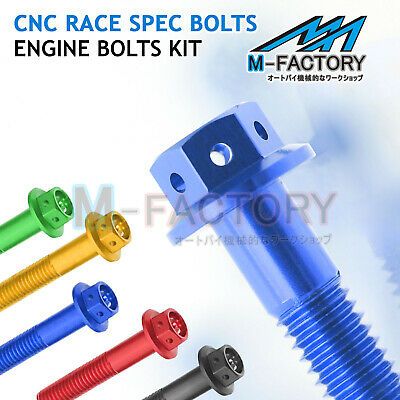 Unscrew the hardware with a wrench.
Unscrew the hardware with a wrench.
To unscrew a bolt broken at a shallow depth, you can lengthen the chip directly by welding. Then a nut or a strip of metal is welded to it. To remove the chip, a wrench or pliers is used. nine0003
If a thin bolt is broken at a great depth, it will not work to unscrew it by welding. If a thick hardware has collapsed, a metal tube can be welded to it (the electrode is inserted into the hole in it).
Their list includes:
triangular files; nine0003
hexagons;
sweep;
screwdrivers with metal handles.
To unscrew a broken bolt with one of these tools, proceed as follows.
Drill a hole in the fragment with a diameter slightly smaller than the dimensions of the tool at hand. nine0003
Drive the tool into the hole with a hammer.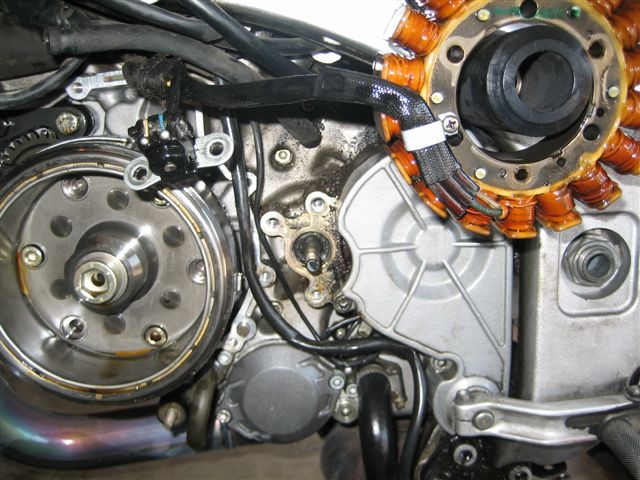 As a result, it will collapse.
As a result, it will collapse.
Try to unscrew the bolt.
This method of unscrewing broken bolts is used only in extreme cases (there is a high risk of damaging the thread) or when it is possible or necessary to cut a new one.
For drilling, you will need left-hand metal drills. nine0003
Mark the center of the hole.
Drill a hole with a thin left drill bit.
Gradually increasing the diameters of the tools, drill out the bolt.
In order not to damage the thread, carefully control the direction of drilling at all stages.
nine0068 Photo #7: Drilling broken bolt
You can buy metal drills and other tools that may be useful for unscrewing broken bolts, working with threaded connections or performing other operations directly in our online store at affordable prices.
Always available:
sweep;
taps;
screwdrivers;
drills;
additional devices;
and many many others. nine0003
We wish you a happy shopping.
more useful information
Useful reviews and Articles
All Articles
April 2, 2021
Methods for Measurement of Production on Production and Homework
28 28, 2018
How to pull out a broken meter 9000
22 May 22, 2018
How to drill a broken drill from metal
July 19, 2017
Cutting metal with a grinder: basic rules
All articles
Subscribe to us
We send discounts for the tool and only useful information!
Didn't find the required item in the catalog?
We are ready to manufacture and supply unique types of tools especially for your order!
Order
We use cookies.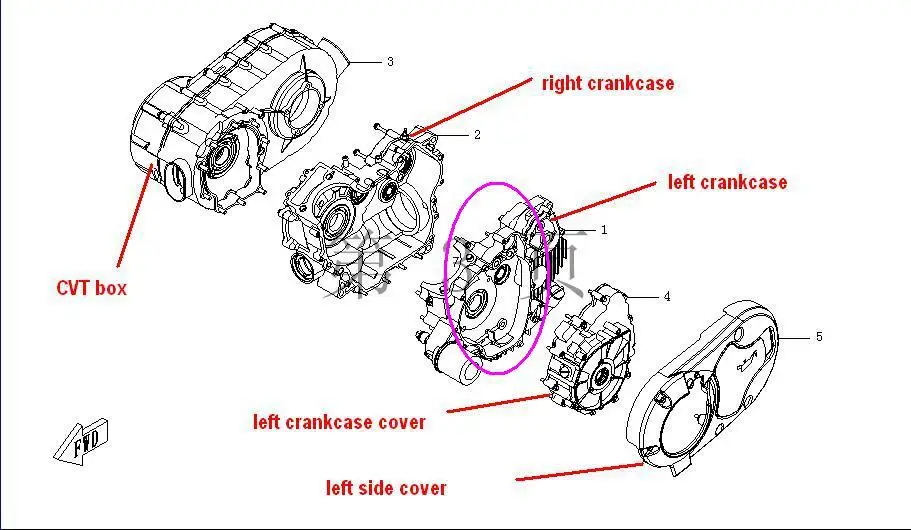 They help improve your interaction with the site.
They help improve your interaction with the site.
I accept
nine0002 ?>Aug 27
Contents of the article:
Let's pay attention to a situation that very often occurs during the repair of automotive and other equipment. Let's see what to do if the bolt is broken: how to unscrew it and get the broken body so as not to destroy the thread. And this is not as simple as it seems at first glance, especially if the damage line is in depth, and not on the surface.
Let's see what to do if the bolt is broken: how to unscrew it and get the broken body so as not to destroy the thread. And this is not as simple as it seems at first glance, especially if the damage line is in depth, and not on the surface.
In this case, the part can be very expensive, be large, have a complex shape. Take the same aluminum oil pan: this is a critical functional unit, it is very problematic to replace it, and it is simply necessary to remove the remnants of hardware from it, and with special care, because its insides are softer than the steel from which the fastener is made. It is worth acting depending on the specific case, because there are several ways to solve the problem at once, but first we will talk about why it occurs at all. nine0003
In the list of the most common causes:
Rust formed as a result of contact with an aggressive or wet environment and provokes uneven wear and destruction at the most stressed point.
The old age of the connection, not noticeable externally, followed by sticking of two parts, no turning and breakage when applying excessive force.
Too tight, resulting in unnecessary stress. nine0003
Manufactured defect, e.g. version with microcracks.
It's good that you can eliminate the consequences of any of these reasons - if you know exactly what to do in each individual situation.
This is relevant when the break line runs inside the part. To do the job with due care, you need to center the working tool with a metal sleeve of the same diameter. nine0003
Another option is to first expand the hole with a slightly larger drill, and then take a smaller one, the same section as the hardware, and use it to remove the remains of the fastener.
There are also special centering devices - these are mainly used by turners, but they are also suitable for solving our problem. You need to act in the same way as in the previous case: first make a wide recess, and then proceed to remove the stuck body.
You need to act in the same way as in the previous case: first make a wide recess, and then proceed to remove the stuck body.
Almost getting ahead of ourselves, because first of all, you can take a number of actions that will increase the likelihood of successful completion of such a delicate operation. They are optional, but highly recommended. So, to simplify the task, it is worth:
Clean the surface by removing grease, dirt, foreign objects - this will allow you to see all those small irregularities and defects that were previously invisible, and correctly diagnose the nature and degree of damage.
Pour (inject) fuel into the hole with a penetrating effect, for example, W-40 - this will help dissolve some of the rust and deposits.
Warm up the unit (functional unit, part) in a problem area with a gas burner - this will partially relieve excessive internal stresses. But here it is important not to overdo it, because if the metal is brittle like aluminum, it can melt.
But here it is important not to overdo it, because if the metal is brittle like aluminum, it can melt.
Tap on the remains of fasteners with a spring-loaded or ordinary center punch - a hammer, several times, lightly. This way you loosen up the fit. nine0003
In two steps:
First you need to take a regular nozzle and center it.
After arming yourself with the one that rotates counterclockwise (let it be a little larger in diameter) and, using it, gradually remove the body.
Be careful and control the direction of movement - then the edges of the working rod will cling to the remnants of the hardware, pushing them up, but without destroying the thread. If any damage occurs, it will be so minor that you can easily fix it with a tap. This method is effective when the fastening connection is not yet very rusty or stuck. nine0003
This method is suitable if the diameter of the remains is relatively large.
 Because in the body you will have to drill a smaller threaded hole, into which then install fasteners with a left notch and start tightening it, going deeper and deeper - it will push out the previously destroyed part.
Because in the body you will have to drill a smaller threaded hole, into which then install fasteners with a left notch and start tightening it, going deeper and deeper - it will push out the previously destroyed part. The only downside is that a drill is required to complete the task, and it is far from always at hand, and you will have to spend one new hardware. Therefore, it makes sense to consider solutions that are easier to implement and universal in everyday life, and put this aside in reserve, in case there is no other way out. nine0003
The choice of a specific method depends on the situation, but in practice the fastening element we are considering most often turns out to be simply licked off (due to poor workmanship). You can remove it and not damage the thread: for this, it is enough to carefully sharpen the head so that its shape matches the size of the key. Well, if you want to minimize the risks, you should additionally impregnate the junction with grease - it will reduce the pull-out resistance. nine0003
nine0003
Now let's pay attention to what to arm yourself with in case of this or that damage - due to the action of rust, excessive pressure or for other reasons.
This is how to unscrew a broken bolt when the break has occurred above the surface of the thread and the edge of the resulting surface is uneven. Here you need:
Clean the contact area, examine it carefully and find the largest ledge.
Attach the tool to the selected point, placing it at an angle; it is perfectly acceptable to deepen an uneven area with a core so that you can lean even more securely. nine0003
Try to turn the hardware with light strokes; if it does not work out, slightly increase the force of the impact until it works out.
Of course, this method must be implemented with extreme care so as not to accidentally damage adjacent elements or make the hole too deep.
Another way to unscrew, drill out a broken bolt and get the broken bolt out of a hole in a hard to reach place. It is carried out according to the same technology as the previous one: they cleared the place, found the stop point, began to turn. Moreover, the remainder should get out quite easily and quickly, because the area of \u200b\u200bcontact with the tool in this case is larger than in the past. nine0003
It is carried out according to the same technology as the previous one: they cleared the place, found the stop point, began to turn. Moreover, the remainder should get out quite easily and quickly, because the area of \u200b\u200bcontact with the tool in this case is larger than in the past. nine0003
Excellent for retrieving loose top fasteners.
A good choice when the head has been torn off or if the defect is found at the very beginning of the thread and there is no screwdriver at hand. Look, the tip of the striper is sharp and therefore great for deforming the cut. A few light blows, and now the surface has already ceased to be flat, it is already possible to hook on it with pliers and pull out the stuck body.
Let's imagine that the head of the bolt has broken: how to unscrew the rest? An original but effective solution is to attach something to it that you can pull on. A hollow fastener with a similar thread is an ideal option in shape, but how to fix it? By heat treatment with plastic deformation!
To solve, in addition to the already named element, you need to take more wire cutters, as well as connect the welding machine and:
Now it will not be difficult to remove the failed hardware and replace it.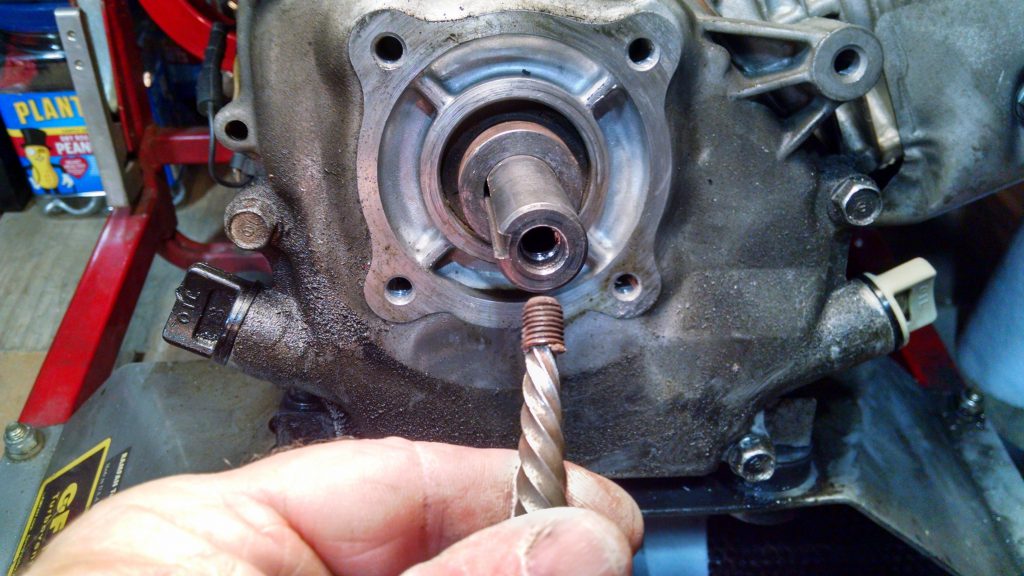 nine0003
nine0003
Also, as an alternative, you can weld the pin - at an angle, and a small one. It will perfectly fulfill the role of a lever that you can pull to remove the body.
When deciding how to get and unscrew the remains of the bolt, if it is broken off, many people prefer welding because it has at least 3 advantages:
quickly; and this does not harm the body of the part, because it continues to remain cold. Also, due to thermal expansion, decoking of the stuck contact is observed. nine0003
Using this method, it will not be difficult to remove even fragments of hardened hardware made of high-strength steel, which are very long, difficult and impractical to drill.
A strong seam is created between the body and the lever (consumable), which allows you to pull out the worn element with wire cutters, even with force.
Welding is also a convenient answer to the question of how to get a broken bolt out of a thread, because it allows you to unscrew any remaining hardware - whether it protrudes from the body, and runs flush, and even deeply recessed. In the first and second cases, you can attach a washer with a nut or a lever and pull, in the third - insert a metal tube and build up - there are options, and each of them is quite simple to implement. nine0003
In the first and second cases, you can attach a washer with a nut or a lever and pull, in the third - insert a metal tube and build up - there are options, and each of them is quite simple to implement. nine0003
This is a specialized tool and it is effective where improvised means pass. Previously, it was wedge-shaped (a cone with special edges) or rod-shaped, and both of these options were hammered into holes. Its screw model, with a chopped spiral, also gained its popularity. Today, it is a whole set of devices, which includes bushings, drills and metal strips.
So, you have a bolt, how to unscrew it using this device:
Fill the contact area with grease or, if the connection is old and stuck, with rust remover.
Make a hole (same diameter as the damaged fastener) using one of the tubes provided as a guide.
Drive the pin to the wedged depth.
Remove the tool element with the remains of the body using a wrench.
After that, you just need to put the worn hardware on a hard surface and lightly hit it several times to loosen the contact force and remove it from the working part of the tool. nine0003
The method of how to unscrew the bolt with an extractor may differ slightly depending on where exactly the fastener managed to break off: rod, get the damaged element.
Flush - also use a punch to center; and when you mark a point for the location of the sleeve, it remains only to repeat the above operations. nine0003
Universal sets are good because they can be used to remove not only hardware, but also screws and even thin studs. At a price they are quite affordable, and when buying it is better to give preference to extractors made of hardened or chrome vanadium steel - they are stronger.
This is one of the most laborious ways to get a broken bolt out of the thread, and it is worth putting it into practice only when there are no other options.
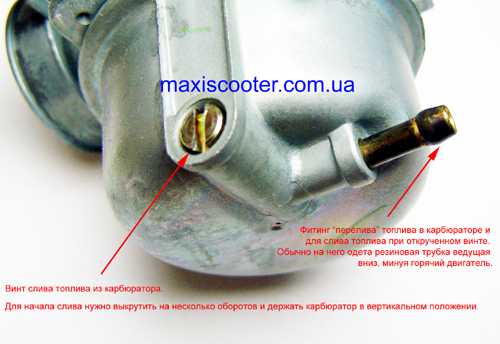 And not only because it takes time, it is important to maintain the accuracy of the work. The slightest oversight - and the internal turns of the case will be damaged. In addition, to implement the method, you will need a whole set of tools:
And not only because it takes time, it is important to maintain the accuracy of the work. The slightest oversight - and the internal turns of the case will be damaged. In addition, to implement the method, you will need a whole set of tools: Metal drill with bit set.
Screwdrivers with different bits.
Triangular file.
Robust pliers or, better yet, a gas wrench.
Tap.
Several needle files in different shapes and sizes.
WD-40 will also be useful: we remind you that it should be poured into the working area 15 minutes before the operation, it will dissolve part of the rust. nine0003
So, the bolt broke off, how to unscrew the broken part from the thread using drilling:
Put on the thinnest nozzle, turn on the drill and make a recess exactly in the center of the hardware; try not to go to the side, this is fraught with subsequent difficulties.
Change the bits, gradually increasing their cross section, until the hole is 1/3 of the body diameter.
Drive the file carefully but firmly, because if it does not hold well, you will not be able to pull out the damaged element. nine0003
Take a pair of pliers or a gas wrench, hold the trihedron with them and begin to make circular movements, trying to pull out the fasteners.
It should work, but how to unscrew and remove the broken part, how to unscrew the broken bolt if it does not give in even after all these actions? It is necessary to expand the hole to a state that it includes another hardware, but smaller and with the opposite thread (usually left). In this case, the second will act as a hat, after being screwed into the first. nine0003
If that doesn't work, just keep increasing the diameter and length of the indentation - until the pressure on the fastener remnants is relieved, then they will start to wobble and it will not be difficult to extract them using a suitable tap.
We remind you that this is a last resort solution, in general, there are simpler, faster, more convenient options.
In such a difficult situation, a hole should be drilled so that its width is sufficient for cutting new threads. Although the hardware can be red-hot and hard to give in. Then it must be subjected to thermal effects - heated red-hot - and then left to cool. It is strictly forbidden to forcibly cool it with water - too sharp a jump in temperature will only lead to cracks. nine0003
The slow temperature change operation must be carried out several times. Due to this, tempering and some softening of the metal will occur, and the damaged element will become easier to drill out. But if the body of the part (unit, functional unit) is made of aluminum, you should be especially careful and make sure that the surface in the heating zone does not warp.
Take a solution of nitric acid and pour it into the hole - this will help to etch out the fragments.
 But remember that the walls of the engine (or other apparatus) must be made of a chemically inert alloy.
But remember that the walls of the engine (or other apparatus) must be made of a chemically inert alloy. Be prepared for the process to stretch for 10-20 hours, depending on the section of worn fasteners, metal properties, ambient temperature. The composition of the active substance should be standard - 57% HNO3 and h3O in a ratio of 1 to 1 - and remember that it is toxic, which means that it should be used with extreme caution, without inhaling vapors. nine0003
There are a lot of cases, but for each of them you can choose your own method, starting from the nature of the damage, the size of the fragments and other conditions. The main thing is that now that you know several options at once on how to unscrew and remove the zalomysh (broken bolt) in a hard-to-reach place, you can implement the most convenient, simple and quick drilling solution in any situation. If you need the help of specialists, please contact Rokta and describe your case, we will advise and offer products for work on favorable terms.